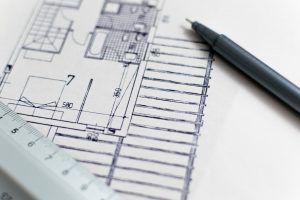 Even the simplest new home is too complicated to be built without plans. Significant renovations or additions may also require plans. The plans are typically prepared by whoever designs the project and are the manifestation of all of the decisions made by the project owner, the designer and other stakeholders during the design process. They are a means of communication between the owner and the contractor, subcontractors, the building official, lenders and possibly others.
Even the simplest new home is too complicated to be built without plans. Significant renovations or additions may also require plans. The plans are typically prepared by whoever designs the project and are the manifestation of all of the decisions made by the project owner, the designer and other stakeholders during the design process. They are a means of communication between the owner and the contractor, subcontractors, the building official, lenders and possibly others.
The plans show how the finished project is designed to look and function and provide information for construction, such as dimensions and building material requirements. For residential projects design plans typically take the form of architectural drawings. They are a two-dimensional representation of the design of the project and may depict the design conceptually or in full detail. A conceptual design plan set might include floor plans, elevation views of each wall and identification of finishes. A detailed plan set might go so far as to show framing elements, certain connections, routing of plumbing, and the like.
Who should design your project? That depends on the nature of the project. To be able to answer this question, you need to understand who can design a home and to what end. Most jurisdictions in the United States have adopted some version of the International Residential Code (IRC) to regulate residential building, often with local modifications. Residential buildings are typically defined as one and two-family homes and townhouses. The IRC relies on the similarities of most residential buildings. They are used primarily, if not exclusively for residential occupancy are usually constructed in similar ways. Because of these similarities, the code can provide rules as to how residential buildings are constructed, provided that they are constructed conventionally and conform to certain limitations. This approach is called prescriptive design. When a homeowner or contractor builds or alters a house “to code”, they are using prescriptive design.
In theory, anyone can draw up plans for a residential construction project based on prescriptive design. However, in practice, it is more complicated than that. First, the IRC is over 900 pages long; no one can memorize more than a fraction of what it in it. Between the revision cycles of the IRC and the varying adoption schedules and modifications in each jurisdiction, there are many different version of the IRC in effect. It can be challenging for professionals to find provisions in the code and correctly apply them. Second, architectural drawings make use of certain drafting conventions and failing to use them properly can lead to miscommunication with the contractor and others.
A residential designer needs to be able to translate the three-dimensional concept of a construction project into the language of two-dimensional architectural drawings in sufficient detail to communicate the design intent. Therefore, it should come as little surprise that residential designers are often come from a drafting background, having developed the experience to become “designer/drafters”. They understand how their projects are constructed beyond the lines they draw on a page (or CAD software), such that they can prepare drawings from concepts. Other designers are educated as architects, but did not pursue licensure, or have interior design backgrounds. Some may have experience as homebuilders and learned drafting along the way. In fact, a lot of residential designers work for homebuilders.
Design professionals are licensed architects and engineers (and in some states interior designers). To become licensed, design professionals must complete the requisite education in their field, often possess graduate degrees, work under the supervision of another professional for several years and pass multiple exams. When an architect or engineer prepares a set of plans, they are not bound by the prescriptive code provisions. Instead, they can base their design on analysis, using the more general provisions in the building code.
The question of who should prepare the plans for residential projects is always project specific. Working with a designer will result in a less expensive set of plans, especially if the designer works for your contractor. Since the contractor can detail conventional framing, plumbing, electrical services and other building systems according to prescriptive provision, for some projects, the drawings may not need to be especially detailed. Thus, for a relatively simple, conventionally constructed project, conceptual plans prepared by a drafter may be sufficient.
Design professionals can add value when their education and experience can be brought to bear, particularly as the complexity of the project increases. Architects and engineers have more tools available to them to tailor the design to your needs and preferences. This may lead to better a design that is more responsive to your needs and wishes, is of better quality and is better communicated by the construction documents. You will be more likely to be happier with the finished project and you may save money in the long run by being able to make better-informed choices.
There are also circumstances where you must have a licensed design professional involved in your project. Generally, this is true when some aspect of your project falls outside the prescriptive code limits. This can be caused by design elements like large wall openings or open floor plans, which may require engineered beams and columns. There are also parts of the country where natural hazards can exceed the code limits. This can be the case for earthquakes in parts of California, for wind in coastal areas of the southeast and part of Massachusetts, and for snow in the Rocky Mountains and much of New Hampshire and Maine. Beware of a home designer with a beam program or other design computation software intended for professionals. It is relatively likely that the designer does not have the education or experience to fully understand the program inputs or to validate the outputs. Their use of such software to make design decisions is likely not covered by their business insurance and may violate the professional licensing laws in your state.
If you are building a new home or substantially altering an existing home, you are going to need plans. Deciding who will prepare these plans, like the choice of a construction contractor, is important to the success of the project. In making this choice, you need to decide whether your project will be simple and conventional or complicated and custom. You will need to honestly assess whether you know exactly what you want or whether guidance from an architect will help you design a home that will meet your needs for years to come. Depending on the circumstances, spending more money during design might save you time, money and trouble during construction and beyond. Your new home may be your largest single investment. Whatever the outcome of the decision, do your due diligence and make the decision deliberatively. It is too important a choice to do otherwise.
The information and statements in this document are for information purposes only and do not comprise the professional advice of the author or create a professional relationship between reader and author.

